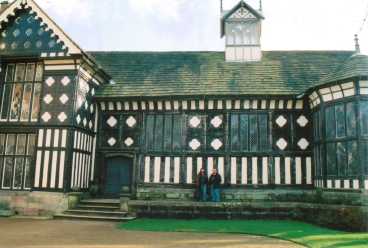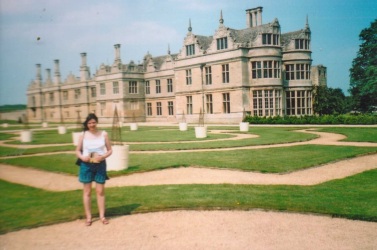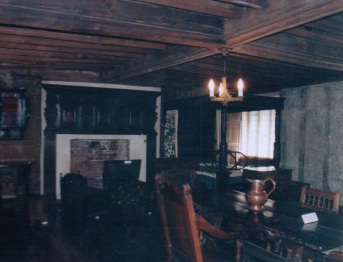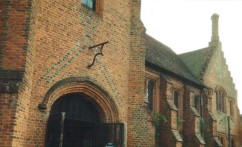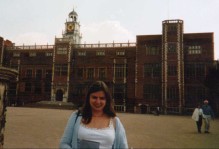I really ought to say England’s Best Stately Home for I don’t know of any I like yet in Scotland and Wales, but left the title should I discover some and want to add them in.
Reader’s recommendations are welcome – please comment if you think you know somewhere I’d like.
But I have very specific criteria – pre 1700, avoidance of chintz, Victorians, and I also care about the morals of the owners. I’m also uncomfortable about displays of wealth for their own sake – slightly ironic, I know.
Basically, this is about Medieval, Renaissance and earlier Stuart homes – timber roofed great halls, carved panelling, plastered ceilings, ornate chimney pieces, high kitchens and open fireplaces, big (especially bay) windows.
I shall go around England in groups.
Old Rufford, Lancs
My first is the STRIPY BLACK AND WHITE TIMBERED houses that grace the west of England, especially the north west, in Cheshire and Lancashire. I immediately come across my first gripe –
Most stately homes are one room wonders.
Out of the 6 – 26 rooms you might see – even 66 in a big palace – I find myself lingering and wanting postcards of no more than 2. Old Rufford’s got my favourite great hall, but it’s a little too carved – I’m not sure I’d want to do much in it, because it’s quite overwhelmingly rich. Little Moreton has a justly famous long gallery. The others are on my wish list, including Ordsall in Salford. Others – like Speke – are places I’m glad to have been, but have no special favourite rooms.
Another group is a county, and it’s all wish list. An extra reason, beyond the buildings themselves, is their familiarity as filming locations. Haddon Hall in DERBYSHIRE has been in 4 of the most recent Jane Eyre adaptations, three of them as Rochester’s Thornfield Hall, although the real inspiration is meant to be close to Bronte’s native Haworth in Yorkshire. Haddon’s a fortified medieval manor with a great hall and a splendid long gallery. (See where I set my Jane Eyre). Another stately home shown in those Jane Eyres is Bolsover, a castle, but being mostly 17th C and not fortressy, I felt it belonged here. I dislike ruined castles but I find the roofless block here appealing. The stables even are impressive and there’s an amazingly detailed Star Chamber. Lyme House stood in for Pemberley in the BBC 1995 version of Pride and Prejudice, but it’s the unseen interiors of the Elizabethan house encased in the classical one which make me include it. The elephant I’m not saying ties into another home by the same family – Ms Shrewsbury of “I think I’m Queen Elizabeth” fame. (I sort of sympathise!) There’s another pleasant ruin by Bess of Hardwick’s glassy mansion whose grandest room is practically a Presence Chamber with a heraldic canopy over a conspicuous chair. She’s got a long gallery, rich tapestries and room height marbled chimneys – but what’s happened to her ceilings? (I’m suspicious some later owners zapped the plasterwork I’m expecting).
Burghley near Stamford on the East Anglia/Midlands border
Hardwick Hall leads me to my next group – the PRODIGY HOUSES, spread about England, which are late 16th C and supposed to be for impressing the above Queen, should she visit. They are near palaces in themselves, full of renaissance details with stone facades. The largest of all – Holdenby Hall – is now dead, except for a small wing which in no way hints at what once stood there. Its builder, Christopher Hatton (Elizabethan Wayne Sleep?), didn’t even get to welcome his beloved Queen. All these homes – Nottingham’s Wollaton Hall, Stamford’s Burghley, Longleat in Wiltshire – look fantastic outside. But inside, there’s little Elizabethan going on. At least Burghley has a strong theme from another era – the late 17th C, with its cascading wall and ceiling paintings. But only the kitchen is Tudor. Kirby in Northants (another Hatton job) is a favourite, although it is ruined, but in a good way – it’s got all the details, just no windows and roofs, except the stately bit. It too is special due to featuring in a familiar film – the 2000 version of Mansfield Park, my favourite Jane Austen adaption for being a naughty one. When I visited, the great hall was part restored, now yellow with a gold and blue ceiling; both it and the state rooms where pleasantly simple and empty. Now I hear they’ve brought these back with full furnishings – to Georgian times, though it’s a 16-17th building?! I’d rather they got that long gallery going again or left it as it is. Mind the peacocks! [Insert sound here!]
Kirby, Northants
I also single Longleat out chiefly because of its owner. Alexander Thynn is not your average marquess. His father put zoo animals in the park and opened it to the public. Alexander did more outrageous things. When I first glimpsed Lord Bath, it was on a leaflet for Longleat: on seeing a man in multicoloured clothes gesturing like a jester, I thought – that’s a magician. Then I saw the signature – in a hand quite unlike usual noble borns’ – and realised this was the owner, welcoming us in his normal garb. Brilliant! Alexander defected from the traditional Tory family seat in the House of Lords to the Liberals. He writes poetry and went to art college. He made bright murals depicting his struggle as [what colour sheep? -a bright one] of his family. His Karma Sutra murals wrestle with his former sexual hangups – which he overcame quite dramatically, judging by his wifelets.
Somewhere else privately owned with cool contemporary paintings is Athelhampton in Dorset. Not sure what the pyramid trees mean (I’m suspicious about secret messages in parterres, even the guidebook hints at it) but this lovely manor house has a great Great Hall and several other good (ie contemporary) rooms – and best of all, it felt welcoming and lived in. In the attic is two of my favourite things – a cinema, and modern paintings. The former even showed a film of itself, From Time to Time, a gentle ghost story with Maggie Smith that didn’t get anything like a suitable theatrical airing; the latter is from Russian cubist Marevna who visited in the 1950s.
I shouldn’t have taken this, but I am naughty!
I also commend Ipswich’s Christchurch Mansion for being free, unstuffy and community friendly. I remember the day Asian music was drifting through the servant’s hall for school event. It also has modern paintings in it – in a changing gallery off the fake marble entrance hall, and an upstairs area which includes impressionist Philip Wilson Steer’s work. My favourite rooms are all pinched from elsewhere, such as the 16th C bedchamber (above), the hall below it and the Wingfield panelling you almost miss on the way to the Wolsey gallery. Christchurch leads me into my penultimate group – the RED BRICK ones – which occur on the east side of England from the south coast as far up as Yorkshire. Like the stripy ones, they look fabulous outside, but often disappoint within. At least the stripy ones usually retain great hall and chamber or long gallery of the period. But many of the red ones don’t even have that. I can only think of one which looks how I’d hope on the inside – Hatfield, in Hertfordshire.
Hatfield Herts: Old and New
Hatfield is exciting to me because the old part is where Queen Elizabeth I grew up. The newer part is connected with her advisor, the Cecils (also at Stamford, above mentioned). The only remaining part of Elizabeth’s time is one side of a quadrangle containing a great hall, built on the cusp of her family’s era. It’s long and open timbered at the roof, of especially mellow brick with just enough furnishing to make it homely. The main house was wrongly used in Sally Potter’s Orlando, for it wasn’t built til after Quentin Crisp’s ‘Eliza our fairest queen’ (as sung by Jimmy Somerville) had passed on. But it’s a splendid Jacobean house, though you see little of it on visiting. There’s a post medieval style great hall, slightly heavy in décor, and a wonderful staircase with the Rainbow portrait of ER I, and one of the best long galleries where you see Lizzie’s little gloves, as well as letters from her and her contemporaries. The other rooms are later, except ceilings and chimneys and also a little overdone – which is also true of fellow Jacobean and once vast Audley End, not far off in Essex.

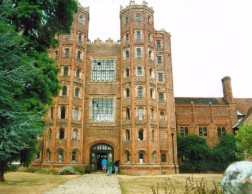
Audley End and Layer Marney, both in Essex
Layer Marney is a tower without a house. I believe it’s the earliest surviving renaissance architecture in England. I think its 80ft high dolphin decorated gate would go well with Hampton Court, also of the 1520s. This is going to lead to my final Quest in this group, as I’m running out of space here – PALACES – because my favourite houses are in fact, royal residences and they deserve a full post to themselves.
I finish with a wish list: Montacute Somerset, perhaps Chastleton, Oxfordshire… Gainsborough Lincs for being a perfect medieval hall, Penshurt in Kent, and Knole – courtyards, gates, ballrooms and a bisexual Bloomsbury bohemian – what’s not to like!?
Feel free to tell me more places to put on it. Her Ladyship is always looking for new homes!
The Elspeth Quest for Britain’s best Palaces will appear in the future, when this Faraway Tree land comes round again

